
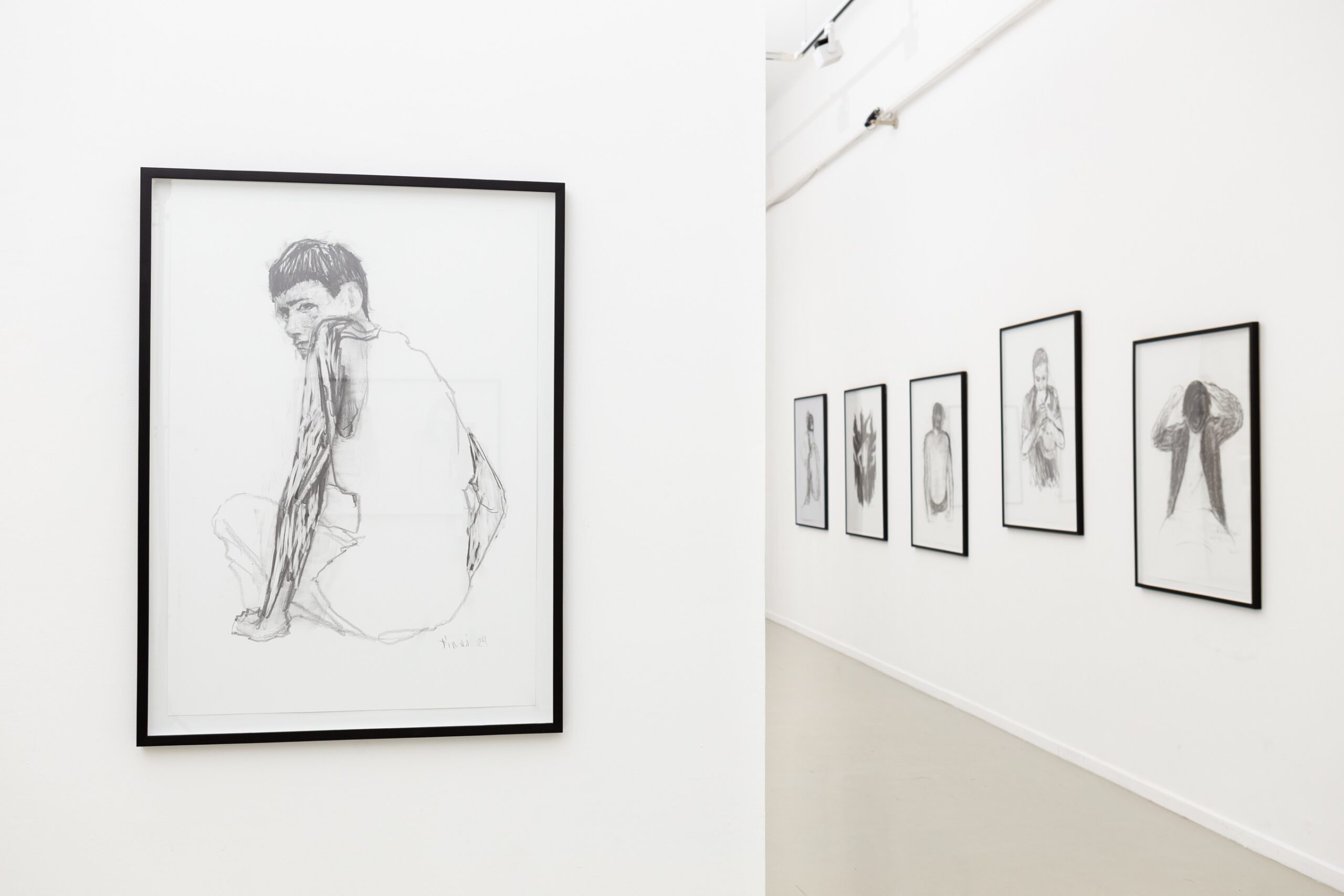
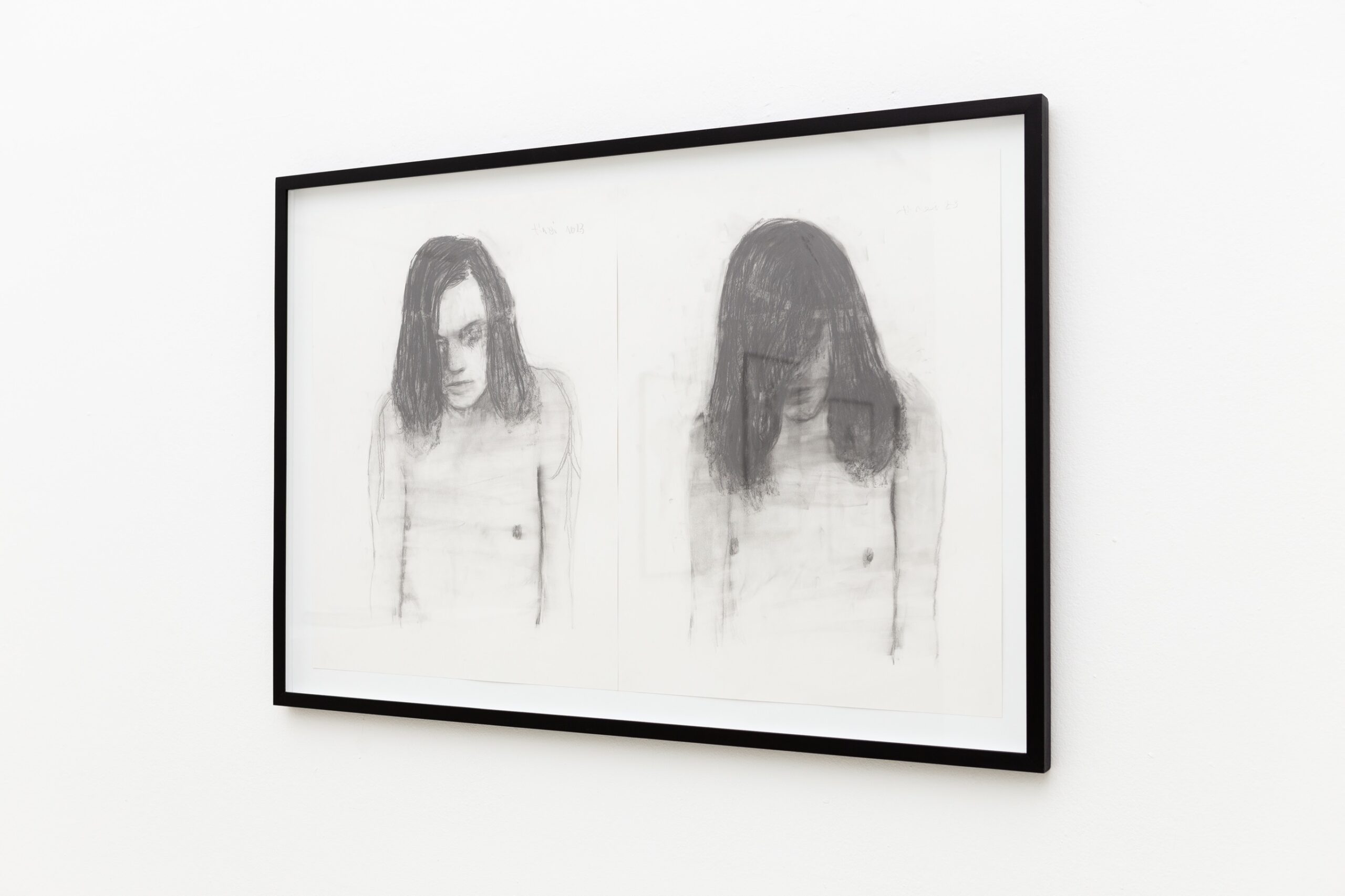
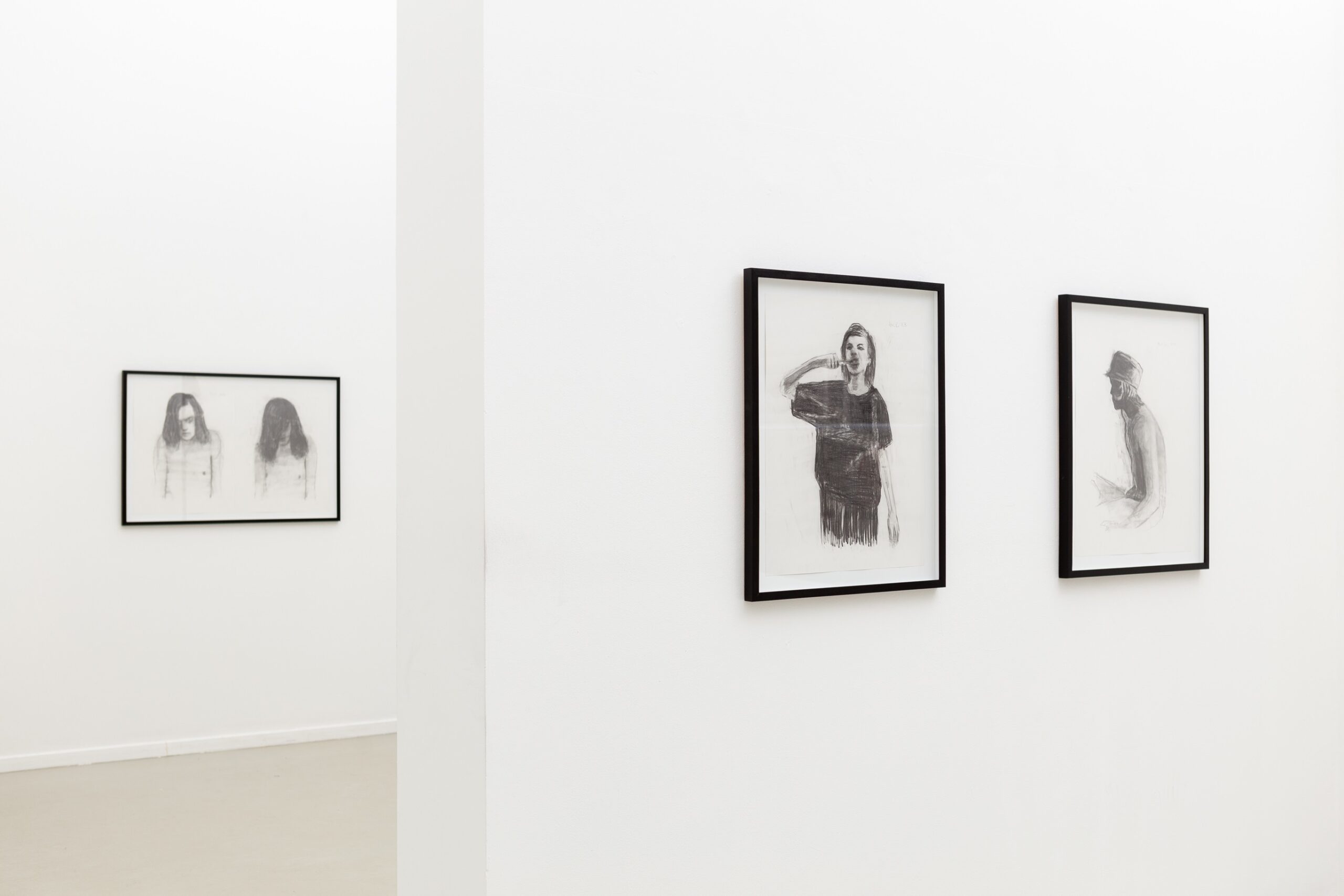
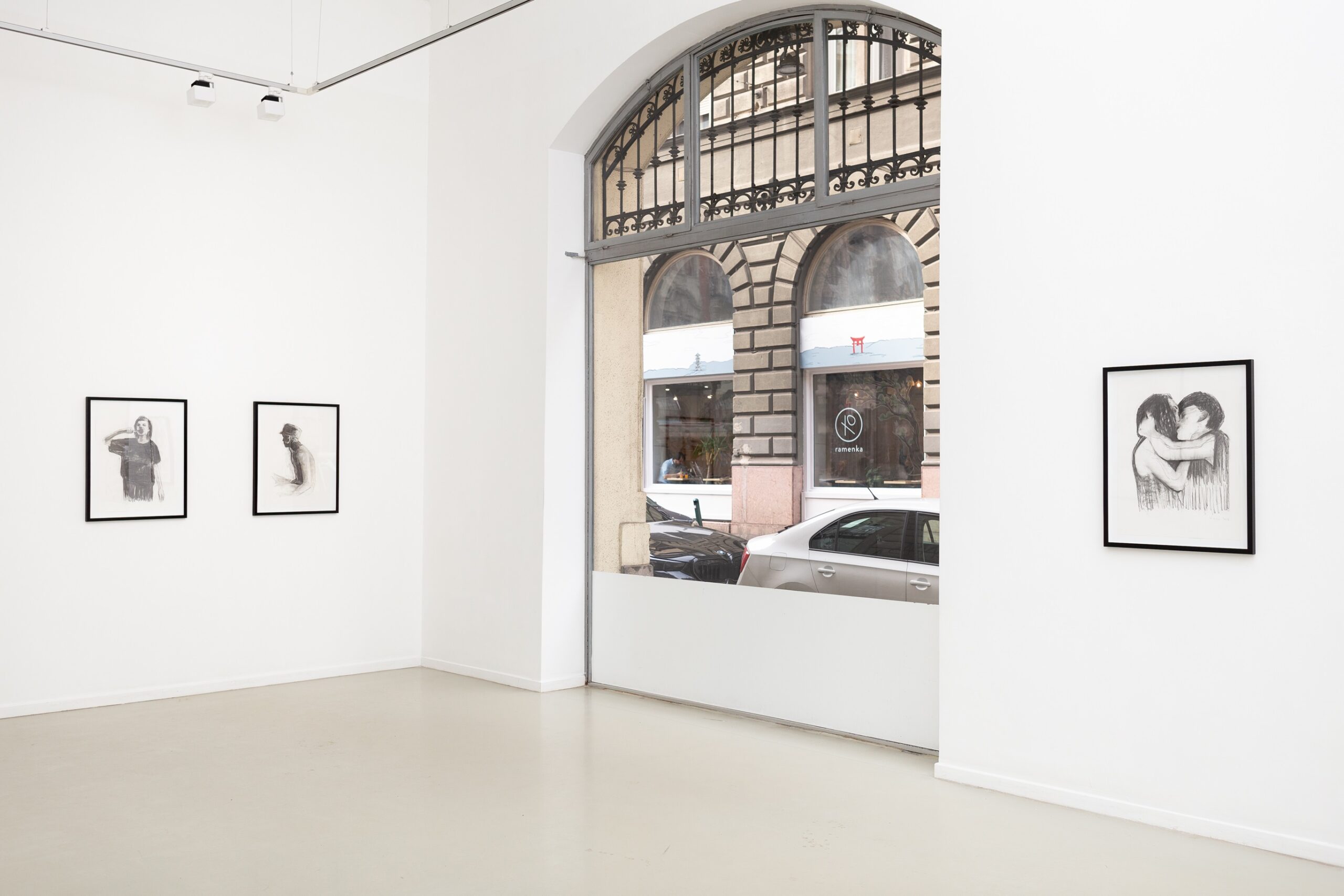

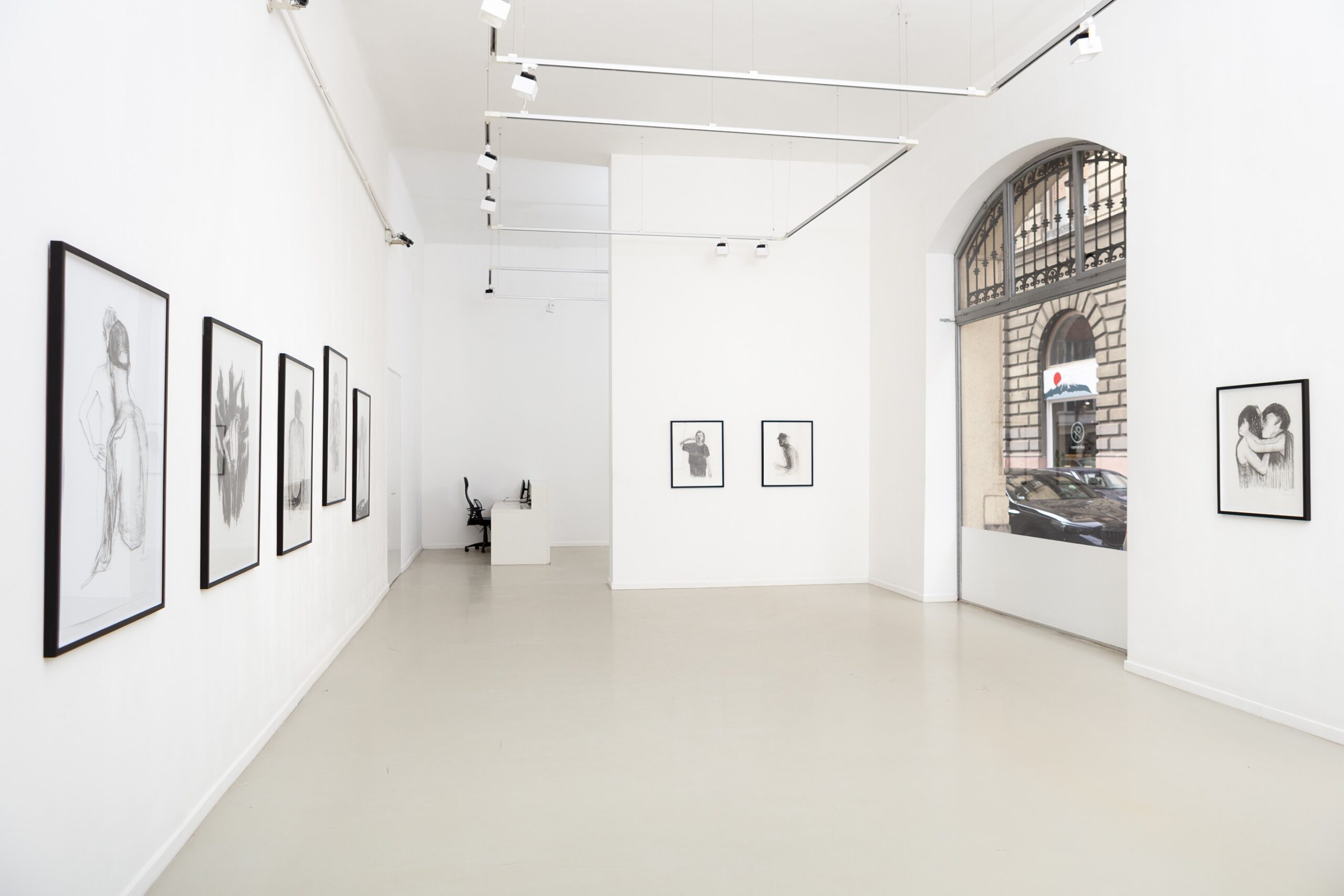
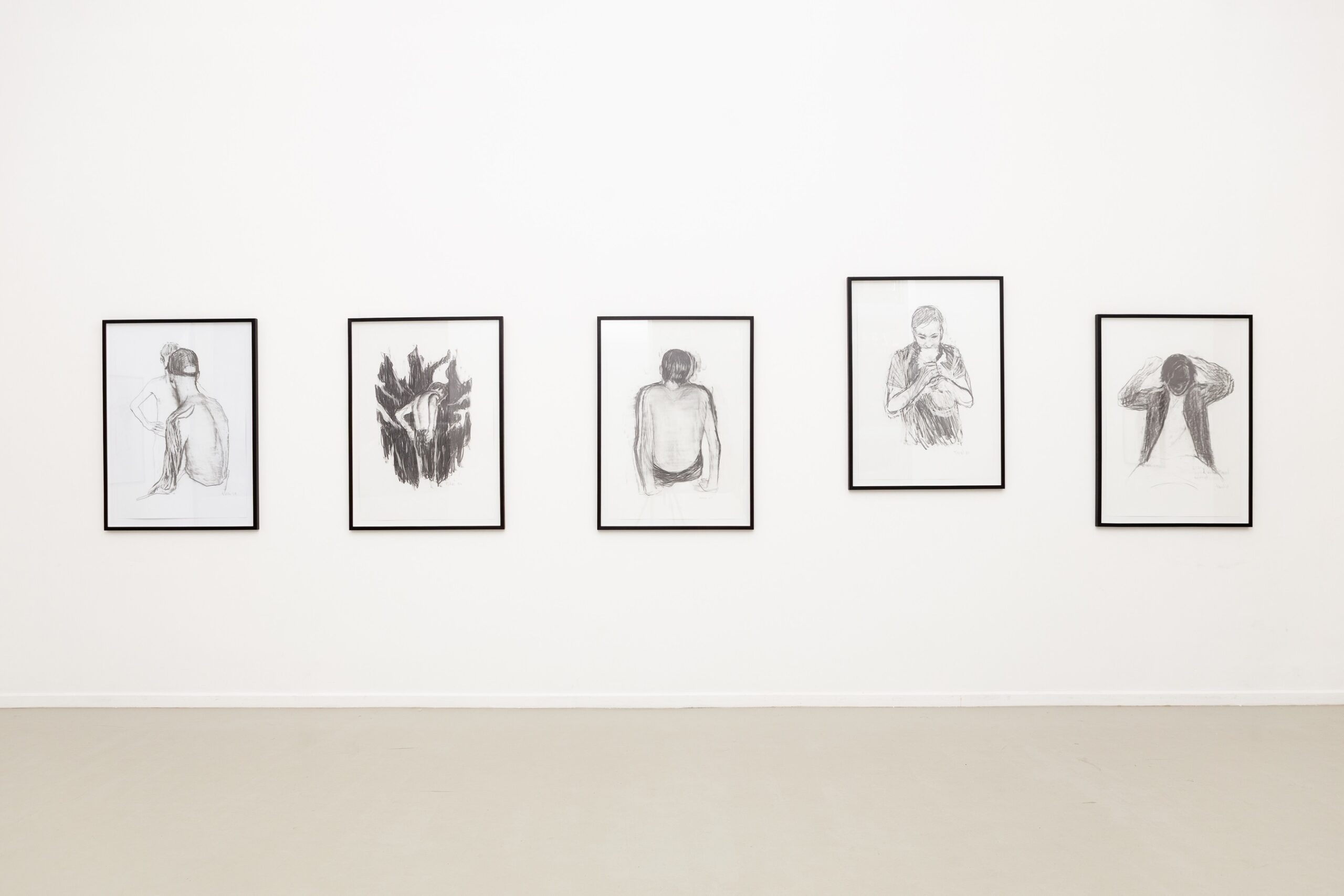
Alecander Tinei
Black on white
The Erika Deák Gallery is delighted to present its latest exhibition, new drawings by Alexander Tinei.
Tinei is known for his arresting portraits of young men and women, who exist in a world that lies between reality and fiction. Tinei’s new series takes us back to his earlier period in the early 2000s, when he focused on black and white graphics. As then, in his latest works we see figures left to their own, with no space or time to infiltrate, no anchors to hold on to, no context to define themselves. The absence of colour, the gesture of storytelling focused on a single gesture, suggests an emotional intensity where there is no release, no escape route, only the possibility of confronting and absolution. Tinei’s figures are full of mystery, as the compositions are devoid of any explanation, not because his figures are storyless, but because they are in fact inclusions, guarding their own history like a time capsule. These are lonely figures, mostly young, exiled men, who thematise not only their isolation but also the individualisation of our present world.
Tinei’s drawings like his previous series of paintings and lithographs, are about the evanescence of human existence—the most important moments of existence. These drawings also study the relationship between time and the body and the way in which the corpus col tempo is destroyed or even annihilated. The fragile yet firm lines, the shadings, the empty surfaces, and the gaps all testify to human fragility. The visuality of these compositions thematizes the relationship between time and memory, how our past stories gradually disappear, how they become null in our minds. The compositions evoke thoughts of absence and passing, which are further intensified by the artist’s strange, gloomy, dreamlike, timeless spaces.
Alexander Tinei (1967, Caushani, Moldova) is one of the most important and internationally recognized contemporary painter living and working in Budapest. His solo exhibitions have been held from New York to Tokyo, and his works can be found in major public and private collections.
Zsolt PETRÁNYI's opening speech:
Dear All!
Fernand Léger, in a 1945 essay, argued that human figures and faces in modern art should only become a compositional element, or more precisely a plastic element. For in classical art, it was the psychological expressiveness of the figure that gave art its subject matter, as he writes: development was hindered by the dominance of the subject. Léger placed the emphasis of contemporary painting on composition, on the 'struggle' of lines, on the plasticity of form, from which he banished the expression and dynamism of emotion. I do not want to be a prophet, but I see no other way forward than a human painting of great power, capable of summing up all the new and known plastic methods, and in absolute order - guided by a calm confidence, because it knows where it is going."
The current popularity of abstract art may well justify Légér's words written in 1945, but if the desire to express the spirit of the age is considered one of the motivating forces of art, then it has been repeatedly proven since then that an abstract approach seeking objectivity, perhaps even pulling art a little towards design, is certainly not enough to express the nuances and developmental trends of the world. The question of how and what the human figure, the expressive posture and face say about the world is a never-ending subject that can always be updated wherever and whenever the artist is depicting a figure.
I know of few authors more consistent on this issue than Alexander Tinei. His paintings over the past decades have shown that humanity has reached an existential turning point in the 21st century, where self-absorption and doubt are stronger than ever. His paintings proclaimed the validity of deep psychology, and that the inclusion of the figure and its centrality in all his technical approaches remains valid. In his paintings of recent years, the background has become an entity in its own right, with abstract compositions on the one hand, and surface experiments on the other, in which the blanket and colours not applied with a brush have taken on a life of their own.
Fernand Léger, quoted in this article, identifies one of the fundamental characteristics of artistic expression in the "battle of lines". In the world of classical abstract art, which is based on composition, this statement characterises the pictorial dynamic, indicating the artist's attitude of detachment from a concrete subject and message. The 'battle of the lines' has also appeared in Tine's paintings of recent years in the context of the figures, but in the stripped-down drawings now on show it is quite another matter.
Tinei now brings us to the origin of his art, the central motif of his works. Portraits in charcoal, pencil and etching show that by abandoning colour and experimental backgrounds, Alexander is able to highlight the element that is most important to him, the human being and his struggle and confrontation with the world. The technique he shows in these paintings is, of course, related to his painting methods: on the white surface, he fades and breaks the solid black lines with the eraser, emphasizing the materiality.
These suggest that the vision of the figures is the result of a creative struggle, as if their character could be arrived at through 'struggling' with the lines. The young men and women in the paintings appear as if they are taking shape on the liminal space between white and black, emerging from the white surface as if they are also struggling with dark forces.
In Tinei's work, the idea of figures symbolizing "humanity" and "age" often arises that, like the figures in, say, Muntean/Rosenbloom's paintings, they are not here with us, that they exist independently of each other and of us, that they represent an alienated reality.
Umberto Eco has attempted to explore the different interpretations of the philosophical concept of "alienation" in an essay. In it, he discusses the alienation between man and man, which he argues, although it can be influenced through awareness and action, 'can never be resolved once and for all'. Alienation, according to Eco, defines, and I quote, 'not only a form of relation between individuals based on a certain social structure, but also the relation which links man to other men, to objects, to institutions, to social conventions, to the mythical universe and to language'. This summary circumscribes all aspects of Tinei's approach, especially the way in which he links alienation to the question of belief and disbelief.
Hans Ulrich Obrist, in a conversation with Gerhard Richter, refers to the theory of the "two-legged stance" of the work, where the work is present in both a professional discursive context and a popular reading. In the case of Tínei, the philosophical question of where humanity is heading, what its prospects are in a world of alienation and disillusionment, and what social and generational critique this implies, may be part of a broader perspective, even involving other disciplines. A popular reading, on the other hand, is much more sensitive and leads us closer to a better understanding of the works. We see black, introspective individuals who look inward rather than communicating with the world. The fragmentation of their forms, the discontinuity of their line drawing, also places their existence in an uncertain space, on the border between the imaginary and the real, while it is this very doubt, their existence and non-existence, their reality and unreality, that most captures the viewer's gaze. They express themselves with gestures, and Tinei describes them with gestures, and in this way they convey their emotions, in which the black line, the striking outline, plays a major role. We know and identify these young people by their hairstyle, their posture, their appearance, but it is still inexplicable how these drawn figures can speak so deeply and so generally about the lives, traumas and the wait for resolution of all of us.
With these words I open the exhibition.
Zsolt PETRÁNYI
For more information, please contact the gallery.
Opening: February 15, 2024, Thursday, 18:00 pm
Opening speech by: Zsolt Petrányi, art historian
On view: February 16 – March 14, 2024
Open: Wednesday - Friday, 12:00 - 18:00 pm, and by appointment